|
|
Written by Ann MacKay, his daughter, for his 92nd birthday in 2008 and updated in 2022.
Biography
Training Stateside
In the field of military history, rarely do military health care providers receive much attention.
World War II, however, was the first war with many modern health care practices.
Field blood transfusions and miracle pharmaceuticals were just two of many new innovative medical practices.
His next assignment was at Camp Tyson where he served as the sanitary engineer to the surgeon.
Camp Tyson was the nation's only World War II barrage balloon training center.
The camp trained servicemen to build, fly, and repair barrage balloons.
They were heliumor
Born:
April 26, 1916, Minneapolis, MN.
Grade School:
St. Cecelia, St. Paul,MN
High School:
Cretin High School, St. Paul, MN
College:
University of Minnesota
BS Chemical Engineering
Masters Chemical Engineering
Marriage:
April 2, 1941 to
Ann Morrison MacKay
Military Service:
Active Duty
Enlisted December 1941
March 1942 - November 1945.
Reserves until 1950.
Military Service:
O’Brien Hospital
Springfield, MO 1942
Barrage Ballon Center
Paris, TN 1942 - 1943
Travel to India
Fall 1943 - Spring 1944
Misarmari Air Base
Misarmari, Assam India
Fall 1944 - October 1945
Fort McCoy Wisconsin, discharge and then home November 1945
1942 - 1943

Tom Wall enlisted in the Army and was inducted in the Army in March 31, 1942, as a First Lieutenant.
He would celebrate his first anniversary as a married man on April 2, 1942.
He reported March 31, 1942, to O’Reilly General Hospital near Springfield, Missouri for the tropical diseases shots before being deployed overseas.
He got sick from a yellow fever injection from a bad batch of solution but the second one did not make him sick.
O'Reilly General Hospital was dedicated November 8, 1941.
It became the pride of the U.S. Army Medical Corps.
hydrogen-filled balloons measuring thirty-five feet in diameter and eighty-five feet in length used in aerial coastal defense.
The camp was located about 8 miles south of Paris, Tennessee.
The two-thousand-acre camp was named for Brigadier General Lawrence D. Tyson, a distinguished World War I veteran and prominent citizen of Knoxville.
The camp began in the early fall of 1941, and at its peak in December 1941 construction crews of over eight thousand laborers erected 450 buildings including wooden barracks, a 400-bed hospital, and a 2,500-seat theater, all of which were served by a modern water system.

In March 1942, officers and enlisted men arrived in detachments of five thousand or six thousand men. By the end of the war, Camp Tyson's occupancy ranged from twenty-thousand to twenty-five thousand soldiers. Wall served there from the spring of 1942 to the late summer of 1943. As the world entered the nuclear age with the dropping of the atomic bomb, barrage balloons became an anachronism. Although originally intended as a permanent military post, Camp Tyson closed after the war.
Wall’s first daughter, Heather, was born in Duluth, Minnesota. His wife, Ann, joined him in Paris, TN with baby Heather, then 6 weeks old. It entailed a long train trip from Duluth carrying a new baby and all the baby necessities. A passenger grabbed the wrong suitcase at the final destination. Ann was surprised with a suitcase full of business clothes. We can only guess what the businessman felt when he opened a suitcase with baby clothes and woman’s clothing. The young Wall family moved every two months.

|
Housing was at a premium so lodging was often substandard with snow blowing under the door in some cases. Heather’s bed was a dresser drawer in some locations. Ann remembers the night the officer of the day babysat so they could attend a Gala for the officers.
Paris was a segregated area in 1942 which must have been an experience for someone from Minnesota.
Wall received a month training in setting up a malaria control unit in a Louisiana swamp where the bugs, heat and humidity were good training for his overseas tour in India and Burma.
His shipping out orders came through that fall and he started the long journey to India first by troop train through Atlanta to Hampton Roads, VA. The train cars were so old that there were gas lamps. The men rode through the countryside with the shades down so no one would see that the train carried soldiers.
A Long Journey
Fall 1943 - Spring 1944
The first leg of the sea voyage to Oran, North Africa was on a Liberty ship.
Shipboard life was not like cruises of today.
He slept near the ceiling in the top hammock of the four-high row of hammocks.
Sea rations were mixed in a big pot. He noticed the Navy sailors were eating real food and for the rest of his life he doesn’t much care for the Navy.

The Liberty ships were cargo ships built in the United States during World War II. They were British in concept but adapted by the USA. They were cheap and quick to build, and came to symbolize U.S. wartime industrial output. Based on vessels ordered by Britain to replace ships torpedoed by German U-boats, they were purchased for the U.S. fleet and for a Lend-Lease program to the Britain. Eighteen American shipyards built 2,751 Liberties between 1941 and 1945, easily the largest number of ships produced to a single design. As a sidenote, the S.S. John W. Brown, is moored at Pier 13 in Baltimore. It is one of two surviving fully operational Liberty ships preserved in the United States. It continues to have history ruises and tours. I have been on one of the history cruises on the Chesapeake Bay.
It was not a straight shot to the destination. After passing the Rock of Gibraltar, the ship urned around and went back out to sea as they were warned that German U-boats were laying in wait along the coast line. They finally made it to Oran and as they came into port, they could see sunken ships where they anchored.
Oran
November 1943
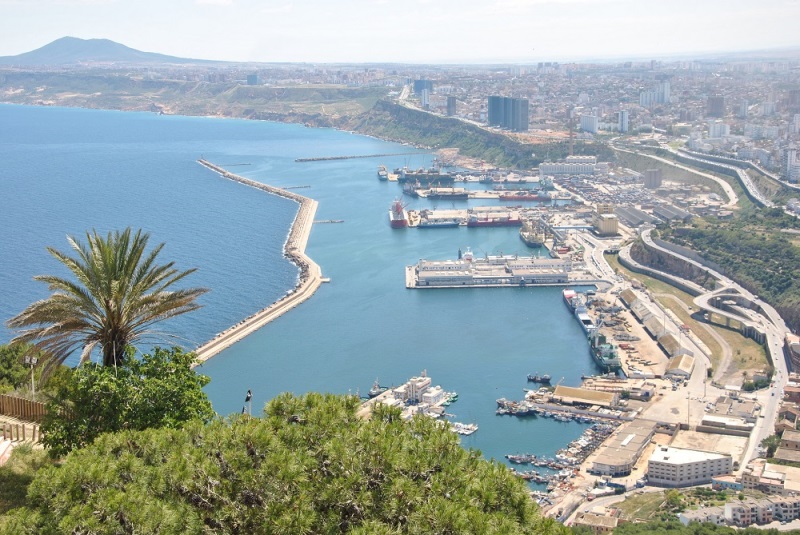
Oran is a major coastal city located in the north-west of Algeria.
The area was back in control of the Allied Forces after the Axis forces were driven from the area in November 1942.
Wall and the eleven men under his command in the malaria control unit waited for a ship to travel from Oran to India.
It was a long wait.
On November 25, 1943, they finally boarded the HMT Rohna, a dilapidated old British merchant vessel converted to a troopship for the next leg of the journey.
The Captain objected to the number of troops on board and demanded that some be removed for the safety of the vessel.
Wall and his men left the ship and watched it sail away carrying 1,981 U.S. soldiers, seven Red Cross personnel, and 195 Indian crewmen and British officers.
Tragedy at Sea
November 26, 1943
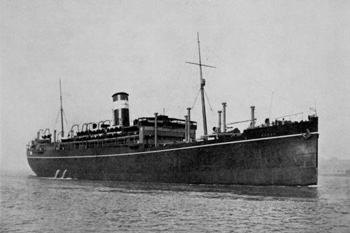
The Rohna was part of convoy KMF-26. On Nov. 26, 1943, about 30 Luftwaffe bombers attacked the convoy.
Several of the Hinkel 177 long-range bombers carried two Hs293 remote-controlled glider bombs, one under each wing.
The Hs293 was, in effect, the first air-launched cruise missile.
A rocket engine launched the bomb away from the bomber, then it glided toward its target under remote (radio) control.
The U.S. government maintained the secrecy around the sinking of the Rohna until the mid 1960s. In the early 1990s, the survivors and the victim's families began to obtain the details under the Freedom of Information Act. On May 30, 1996, a memorial to the Rohna was dedicated at the Fort Mitchell National Cemetery in Seale, Ala. A documentary, Rohna Classified written and directed by Jack Ballo is in post production in 2022.
Oran to India
Winter 1943 - Spring 1944
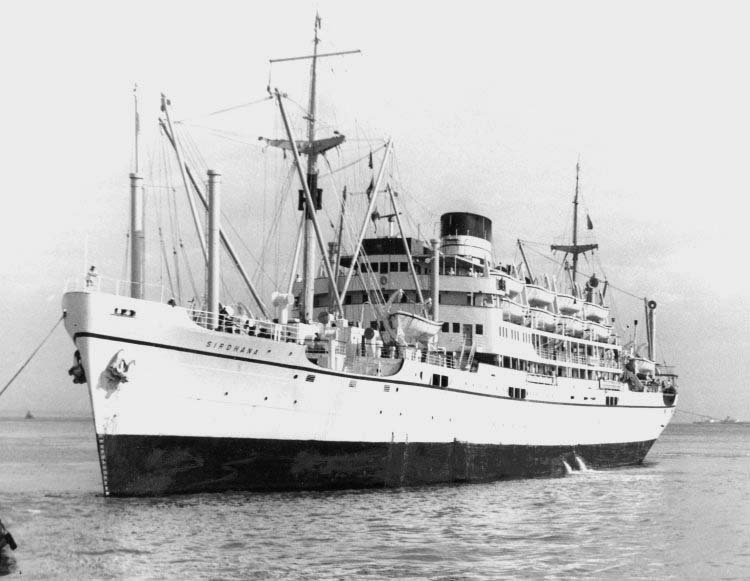
The wait for another ship extended into the new year.
Finally, he sailed for India on a ship owned by the British India Steam Navigation Company (BI).
This was a much better ship than the Liberty ship that traveled across the Atlantic.
BI had a long history of service to the British and Indian governments through trooping and other military contracts.
BI ships were sunk by the dozen in the Second World War. The terrors of dive-bombing and guided missiles added to the threat of the conventional U-boat. In all, 51 vessels grossing 351,756 tons were lost in the struggle — almost half of BI fleet was wiped out. But this ship did make it to India.
Wall was served in style in the formal dining room with multiple forks and knives at the table setting. This was in sharp contrast to the enlisted men below who complained of bugs in the food. Although the officers had tea in the afternoon and had nice cabins, they were ordered to wear life jackets and full uniforms at all times. The ship left January 17, 1944 sailing through the Suez Canal which was only 300 feet wide at some points. They could see the camels in the desert. He was on police duty carrying a side arm to keep small boats away from the ship. A sailing boat did sink after getting caught in the wake of the ship.
China-Burma-India Theater
1944 - 1945
It was another long journey to reach the final destination in India.
Here is description of what transportation was like as he made his way to his duty station.
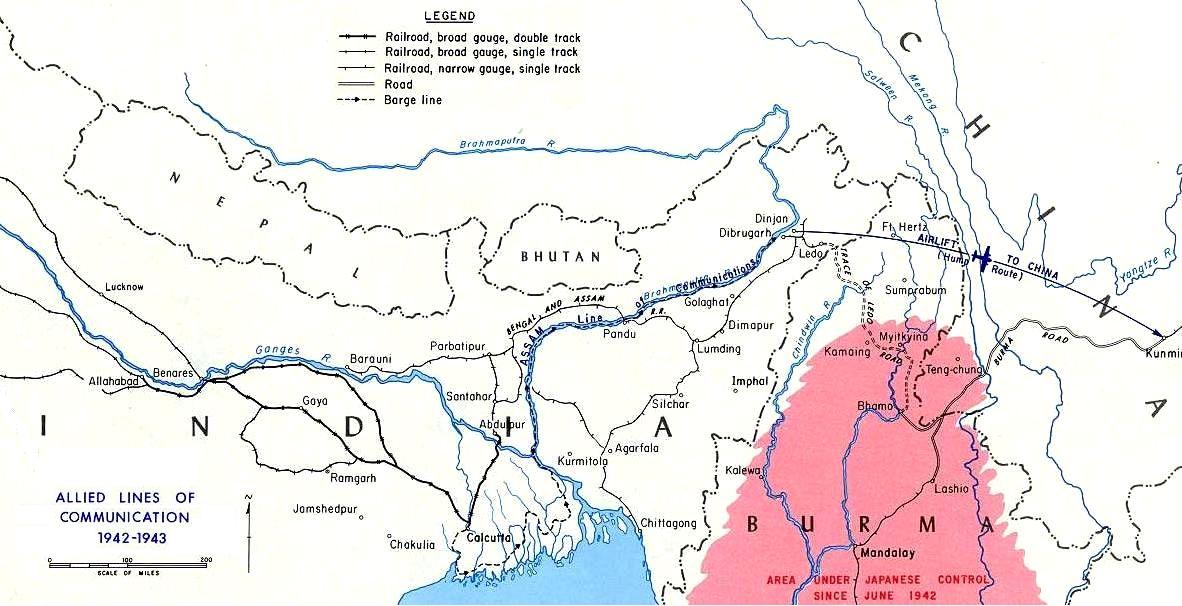
|
The transportation system leading from Calcutta into Assam, called the Assam Line of Communications (LOC), was described by an Army logistician in the War Department as
“The most fascinating and complex problem we have in the world.”
It consisted of rail, water, rail-water, water-rail, and to a limited extent, rail-highway routes.
The Bengal and Assam Railroad was the main carrier on the LOC.
Supplies were shipped from Calcutta over a broad-gauge line 200 and 275 miles respectively to Santahar and Parbatipur.
They were the principle points for transfer from broad-gauge to meter gauge railroads.
The rail wagons then moved to the Brahmaputra River where they were ferried across, and then proceeded to Tinsukia, whence they traveled over the short meter-gauge Dibru-Sadiya Railroad to Ledo, 576 milesfrom Parbatipur.
![]() Transportation in the CBI Theater
Transportation in the CBI Theater
Wall was in charge of the food and water in one car for the trip from Bombay to Calcutta.
They used chlorine tablets in the water.
Every station had a Hindu toilet on one side and a Muslim toilet on the other.
Background on the China-Burma-India Theater
Officially established 3 March 1942, the China-Burma-India Theater of Operations (CBI) is often referred to as the Forgotten Theater of World War II.
The European, Mediterranean, and Pacific theaters received more supplies, more manpower, and more publicity than did CBI.
Of the 12.3 million Americans under arms at the height of mobilization, only about 250,000 were assigned to CBI and comparatively few Americans were in combat in China, Burma, or India. CBI was important however to the overall Allied war effort because of early plans to base air and naval forces in China for an eventual assault on Japan. Allied forces, mostly British, Chinese, and Indian, also engaged large numbers of Japanese troops that might have otherwise been used elsewhere. America's major contribution in CBI was getting war materials and the manpower to where it was needed. Army Air Forces flew supplies to China while Army Engineers built the Ledo Road to open up a land supply route. Except for stories of “Vinegar Joe” Stilwell, Merrill's Marauder's, and Brig. General Robert L. Scott, author of God is My Co-pilot, CBI did not often make headlines in the newspapers back home. [Scott died in Warner Robins, GA where I lived at the time February 2006 at age 97.] The early importance of CBI quickly faded as the war progressed. Thus the Forgotten Theater label remains to this day.
The goal of the China-Burma-India theater was to transport supplies to the forces of the Chinese Central Government.
To accomplish this mission, it was necessary to augment existing air transport facilities and to build a road from India to the Burma Road leading to China on ground which it hoped to wrest from the Japanese.
These major activities had to be carried on more or less simultaneously.
In addition, Army Air Forces supported Chinese, British, and American operations.
![]() Preventative Medicine in World War II: Malaria
Preventative Medicine in World War II: Malaria
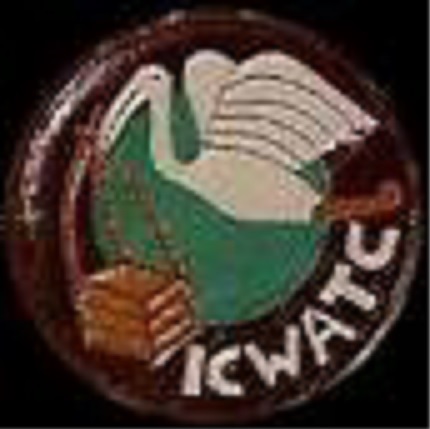
|
Other means were still necessary, however, to move the enormous quantities of gasoline, expendable supplies, vehicles, and other heavy equipment. A supply route started in December 1942 to extend from the Ledo area of Assam, India, across the Patkai Range through the Hukawng and Irrawaddy Valleys to the old Burma Road, subsequently renamed the Stilwell Road. This project involved construction through virgin jungles crossed only by poor foot trails or pack trails and peopled by indigenous tribes. During 1943 and 1944, when construction of the road, pipelines, and telephone lines was continuing as closely behind combat operations as supply and climatic conditions would allow, great quantities of material were moved inland from the ports for construction purposes and to build up a backlog of supplies for shipment over the road on its completion. The road was finished and opened for the first China convoy on 1 February 1945 and was officially closed on 31 October 1945.
Weather Conditions
In India and Burma, the wet (monsoon) season which starts in May offers high temperatures and humidity with torrential rains on a daily basis.
Monsoons are seasonal winds that blow from one direction for approximately six months, bringing torrential rains, and then blow from the opposite direction for the remaining six months, during which little rain falls.
As the season progresses, the humidity becomes higher and the actual temperature lower, although the perceptible temperature increases. After the rains, the temperature decreases and the cool season has arrived. This continues until late in February. Early in March, the hot season begins with its high daytime temperatures but relatively cool nights. This condition prevails until the monsoon breaks. To give you an idea of the amount of rain that falls, a precipitation chart labeled 1943 indicated 108 inches of rain in June fall in the area Wall was stationed. My father hated to be hot for the rest of his life.
The Hump
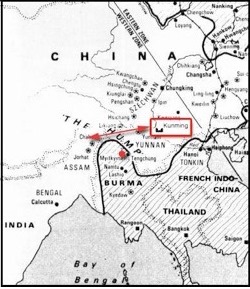
The Hump, the name given by Allied pilots in the Second World War to the eastern end of the Himalayan Mountains over which they flew from India to China to resupply the Flying Tigers and the Chinese Government of Chiang Kai-shek.
The pilots started flying The Hump in April 1942 when the Japanese blocked the Burma Road, and they continued to do so until 1945 when the Ledo Road opened.
Flying over the Hump was a risky endeavor. The air route led first over the Himalayan foothills and finally to the mountains, between north Burma and west China, where violent turbulence and terrible weather was standard. Transport planes flew around the clock from any of thirteen bases in northeastern India, landing about 800 kilometers away at one of six Chinese airfields. Some crews flew as many as three round trips every day. Due to the isolated region, parts and supplies to keep the planes flying were in short supply.
Malaria Prevalence
With all that moisture it is not hard to see that malaria is an important disease in both India and Burma.
In India, with a population of about 388 million in 1941, it has been estimated that there were between 100 and 200 million cases of malaria and between 1 and 1½ million deaths each year from this disease.
In some instances, U.S. troops were stationed in areas of hyperendemicity, while large numbers were in areas of moderate to high endemicity.
The seriousness of the problem is summed up by Gen. Douglas MacArthur's statement to Paul F. Russell, MD, M.P.H., Sc.D. in May 1943 “...this will be a long war if for every division I have facing the enemy I must count on a second division in hospital with malaria and a third division convalescing from this debilitating disease!”
Beginnings of Malaria Control
In all portions of the theater where there were troops, malaria was present, often highly endemic, and in certain areas hyperendemic.
With this situation and with the impossibility of separating troops from the local population, only the application of all feasible means of malaria control could keep the rates from being excessive.
Unfortunately, at the start of operations, both anti malaria supplies and personnel were insufficient to establish control.
At first such supplies as were available to the British were shared with the U.S. forces, and, in addition, permission was given to procure mosquito netting and other supplies locally, even though all supplies were short. Thousands of laborers were made available for drainage projects and for the construction of mosquito proof quarters.
Many troops did not have sufficient instruction in malaria prevention, and malaria discipline was lax. Intimate contact with the highly infected reservoir population while working in uncontrolled areas, where most personal protective measures were all but impossible, helped to increase infection. Education was stressed, and malaria discipline improved as soon as the importance of the problem was recognized. U.S. Forces from mid-1943 onward waged a fast and successful war through some of the most malarious areas on earth.
It is ironic that in 2011 malaria remains a public health problem in more than 100 counties and causes over one million deaths each year.
![]() Malaria Foundation: DDT
Malaria Foundation: DDT
Malaria Control
So this is the environment, Wall and his 11 men encountered at the ATC Base, Misamari, in the state of Assam, India, Asia.

At the time Wall arrives on the scene in India, there were only 10 Malaria Control Units in the entire CBI theater. Seven more were scheduled and due to be activated for the theater. Wall was part of the wave of control units that came in 1944.
As supplies and personnel became available, areas were brought under control and rates dropped. After the use of DDT was instituted, still further reductions were noted, and fnally, with employment of general Atabrine suppressive treatment in the more highly endemic areas, rates showed a further decrease. When all these various means were in operation, the rates dropped to a small fraction of what they had been in the early days of the China-Burma-India theater.
Wall reports that when he arrived, the malaria infection rate was 1500/1000 men per year. That means men were getting reinfected with the disease. The rate dropped to a fraction of that under his watch.
A big job was to get the men to protect themselves with head nets, mosquito netting and to use mosquito repellants.
Mosquito Control Measures
Larviciding was one of the most important methods of malaria control and was utilized throughout the China-Burma-India theater.
A larvicide is a type of insecticide used to control mosquitoes indoors and outdoors.
They work by killing mosquito larvae before they can grow into adults.
The ease of application by untrained labor added to the desirability of stressing this method.
It was used extensively where other methods were not feasible, for example, in rice fields which could not be drained because of their essential food crops in low, flat areas which could not be drained satisfactorily, in water tanks (that is, reservoirs) essential to the life of villagers, and in breeding places requiring only temporary treatment or control only until more permanent measures could be put into effect.
When DDT became available, small amounts of it were dissolved in oil and this acted as a more effective larvicide. Smaller amounts of the DDT solution could be spread effectively over larger areas than could be controlled by simple oil sprays. In the China theater, waste motor oil and tung oil kerosene were mixed and extensively used as a larvicide. DDT dusting powder was widely used to control mosquito breeding in rice fields. In addition to the ground larviciding, the air-spray program was established. It was found that this method was useful in large, flat, inaccessible swamp areas and also in quickly controlling the mosquitoes in newly captured areas. Effectiveness was definitely limited by rough mountainous terrain, which kept planes high, by dense jungle canopy, and by monsoon rains which frequently prevented routine operations or washed away the DDT immediately after spraying.
Clearing was done extensively in connection with drainage. In many cases this was the only method of revealing detailed topography so that drainage could be established. In addition, continued clearance of secondary growth in established drainage canals and other waterways was necessary so that larviciding and inspection crews could have access to mosquito breeding areas. For all these operations, simple hand tools were all that were available in the majority of cases; in some sections, however, power saws were used effectively in clearing logjams and a right-of-way.
Drainage - Adequate drainage wherever possible and larviciding of other areas constituted the main anti-larval operations. Literally hundreds of miles of drainage canals were dug and maintained by the malaria control detachments. In all but a very few areas, this work was done by laborers under the supervision of the control detachments or other personnel working for them.
In some of the northern Burma areas, dynamite was used to establish drainage. This was an effective method and required much less manpower in an area where manpower was limited. Of course, labor was needed to maintain this drainage once it was established. No machines were available for ditching within the theater.
Adulticidal Sprays
Space spraying was carried out in buildings throughout the theaters whenever the necessary materials were available.
Aerosol bombs, hand sprayers, and, knapsack sprayers were used.
Particular attention was given to barracks, mess halls, and latrines.
The effectiveness of this method against flies led to its use in buildings where mosquitoes were not the primary problem.
The frequency and thoroughness of such spraying depended upon efficiency of the spraying crews.
When quantities of DDT became available, an intensive residual spraying program was started. The details of application varied within the various sections of the theater. Village buildings within the supposed mosquito flight range were sprayed by the malaria control detachments, while in some areas they also sprayed troop quarters and other buildings. When the spraying of the very numerous local villages constituted a major problem, the spraying of military quarters was left to the organizational anti-malaria details. These men were trained whenever possible by members of the malaria control detachments.
Wall and his men rigged up their own DDT spray using a solid DDT powder which was dissolved in an oil drum with kerosene and GI soap to make an emulsion. His unit never receivedthe mixed emulsion, they had to make their own. The spray would kill the larvae.
In 2005, Wall wrote a letter to the CDC in response to a letter to the editor regarding malaria control.
Here is what he wrote:
| Your letter to the editor in the WSJ on 1/11/05 brought back memories of over 60 years, a demonstration of the use of DDT for killing mosquito larvae at Reelfoot Lake, TN in the summer of 1943, when we were told only a pound of DDT was available in the U.S. at that time. An intensive two-week course was held on the identification of anopheline larvae and adults at Fort McPherson in Atlanta: training for prospective malaria control officers was held later that summer in the simulated tropics of southern Louisiana. The U.S. transport authority put our unit aboard the British transport, named “Rohna” scheduled to hold 2200 men. We, grudgingly were put ashore in the desert to await transport. We learned later from survivors in Bombay that the ship was sunk by a German radio-controlled glider bomb a few days out and 1100 men lost. It has only recently been publicized that outside of Pearl Harbor where the ships were not at sea, this was our greatest loss of life at sea. Our Malaria Control work was done at two air bases on the West side of the Brahmaputra River. Education in the use of repellent, bed nets, DDT spraying of Indian habitat and adult and larval control lowered the malaria rates to a reasonable level. The cases of the falciparum parasite infection occurring just prior to our arrival helped in the adoption of new habits by the airmen. Judicious use of DDT was very effective. An emulsion was not available the first year so we made it from fuel oil and GI soap in 55 gallon drums. Although the overabundant use extravagant insecticidal use of DDT after WW II was inexcusable, those of us who experienced trying to control bedbugs in the metal cots in the barracks and trying to keep the cockroaches from taking over the mess halls having hollow wooden walls, and farmers using lead arsenate and nicotine sulfate, reasonable use of DDT or similar insecticides is a necessity. |

|
Mosquito Proofing
Throughout the theater, the necessity for screening and mosquito proofing was stressed.
Due to a limited supply of materials, more were distributed, by order of the theater malariologist, to the areas of higher endemicity than elsewhere.
Hessian cloth (burlap) and mosquito netting were used.
During the early days of the theater, the entire supply was of British manufacture and was very scarce.
During 1944 and 1945, large amounts of American-made netting and nylon and wire screening arrived to supplement the British stocks.
However, it was not until midsummer of 1945 that sufficient quantities could be moved to the forward areas in Burma to meet the demand.
Mosquito proofing in the China theater was never adequate. The malaria control units distributed the mosquito proofing supplies, supervised installation, and checked maintenance. Without this skilled assistance in the India-Burma theater, mosquito proofing would have been much less effective.
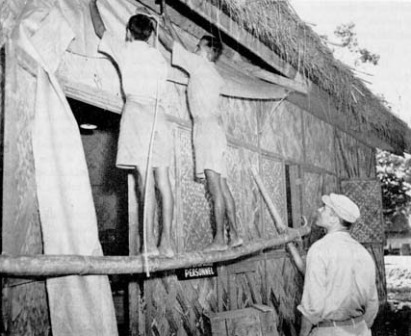
|
The standard materials were burlap (hessian cloth) for walls and ceilings and mosquito netting for doors and windows. The materials deteriorated rather rapidly in the jungle but were usually effective as long as the organization was stationary. Both the American pyramidal and the British EPIP (European Privates, Indian Pattern) tents provided comfortable living quarters when placed over a wooden framework, elevated to give 6-foot sidewalls, and then mosquito proofed. Nylon and wire screening was used in relatively permanent buildings, such as hospitals and mess halls.
Basha-type buildings (grass and bamboo construction) were often mosquito proofed by native contractors under the supervision of malaria control personnel. This method was very effective, and as the men became trained in its use, efficiency was increased and waste decreased. Maintenance of mosquito proofing was the responsibility of the individual organization but was checked by malaria control personnel. In the areas where frequent movement of the organization occurred, there was considerable but unavoidable wastage.
The Malaria Control Unit headed up by Wall used native crews for the mosquito proofing.
Bed nets and jungle hammocks were used throughout the theater. Early models of bed nets were of poor quality; they restricted air movement, and became rapidly mildewed. They were hot and smelly. Later models were made of a tightly woven netting and were less objectionable. Little trouble was experienced in enforcing the bed net regulations. Jungle hammocks were used in forward areas until permanent quarters could be erected.
Mosquito Repellents
Ample quantities of insect repellent began arriving in the China-Burma-India theater in the summer of 1943, and it became one of the few items of which the supply exceeded the demand.
Repellents were universally objectionable to the troops, as they added to the general discomfort. They often smarted when applied to wind-or sunburned skin, they were sticky and oily, they made the user feel hot, they soiled clothes, and dissolved plastic. They were not used by the average soldier except under pressure from his commanding officer or when there were overwhelming numbers of mosquitoes. Various methods of using the repellent were tried with but fair success. In some sections of the theater, it was impossible to go to GI movies unless one submitted to a liberal application of repellent. While all individuals had repellent available and most believed in its effectiveness, its use was not as general as it should have been.
Misamari
Wall was stationed at Misarmari, the army air base which served the fox air route over the Hump.
The main headquarters were in Chabua, Assam, India.
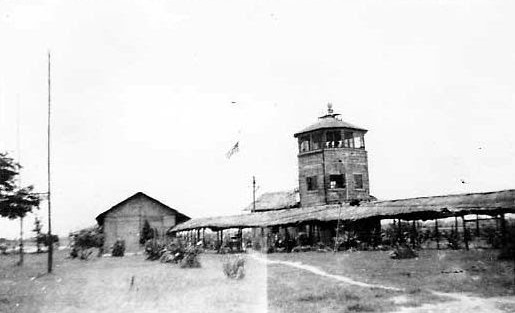
Misamari Air Base opened in November 1943 as one of the 13 bases for flying over the Hump into China.
His unit was split up with one half of the men going to Tezpur about 20 miles away. Tezpur was founded by the British colonial administration in 1835 as the headquarters of Darrang district. Tezpur also has a very old connection with the Tea Gardens and Britishers. During British rule it was a leading point for loading tea for carrying them in steamers. The Tezpur air base was completed in November 1943. The Tezpur air route was labeled Easy while the Misamari route was labeled Fox.
As the air lift to China grew, the number of men increased with over 10,851 stationed in the area in December 1943. This made for a lot of malaria education and control measures. Wall headed up the first Malaria Control Unit at Misamari and Tezpur.
The Local News
The Hump Express was the official weekly newspaper of the India-China Division (ICD) of the Air Transport Command (ATC) of the U.S. Army Air Force in the China-Burma-India (CBI) Theater of World War II.
Copies are available online. The pages have been recreated from original 1945 issues of the newspaper, the original stories, the original pictures, a unique history of ICD.
Here is an article from the March 22, 1945 issue of Hump Express:
|
Atabrine Program Fights Malaria In Assam, Bengal
Hq., Calcutta - ICD has begun a program of malaria suppression by the use of atabrine throughout the Assam and Bengal wings, it was announced this week by Col. E. A. Abbey, division surgeon. No effort has been spared to insure the completeness and regularization of the atabrine plan, which has been put to a long, thorough test in the Southwest Pacific and found invaluable in minimizing the disease. Kills One Type Personnel with assemble by roster every day after a meal and each man will swallow one atabrine tablet, washed down with a glass of water. The fact that he has taken the tablet will be noted by the non-com in charge. A man who misses a day must take two tablets the following day. Suppressive atabrine, it is pointed out, will not prevent malarial infection, though it will keep a man from becoming ill with malaria. It kills one type of malarial parasite, malignant tertian, but only suppresses the other type, benign tertian. This means that when he gets back to the States a man may have malaria if he has been bitten by an infected mosquito. Therefore it is necessary to continue all the same personal protective means used before starting atabrine dosage, including wearing of protective clothing and use of repellent and nets. Rumors Exploded Because rumors concerning harmful effects of atabrine in the past have interfered with its successful application, the surgeon's office is eager to spike them at the beginning of the atabrine program in ICD. Most pernicious, and utterly without foundation, say the medicos, is the widespread notion that atabrine induces sterility or impotence. No case of sterility or impotence due to atabrine ever has been reported from the areas where it has been administered to many hundreds of thousands of men under Army supervision. Another erroneous rumor was exploded when exhaustive tests proved there was no diminution of night vision from the use of atabrine. Fear of yellow jaundice also inhibits many in the use of atabrine. Atabrine is a dye, the physician points out, and one of the most natural consequences of its use is the addition of a yellowish tinge to the pigmentation of skin and eyes. This is completely harmless, Col. Abbey said. Atabrine should never be consumed on an empty stomach, and never by a person suffering from dysentery, in whom it may cause nausea, according to the surgeon. There is always a certain incidence of nausea among large groups beginning the preventive dosage, he added an individuals affected by this symptom should report to a medical officer at once in order that the precise cause may be determined. Atabrine treatment will be continued until an individual has spent 30 days in the U.S. or some other area where it is not required. The fact that the individual is taking atabrine will appear on his service record, and medical officers in the area will be acquainted with the most efficacious methods of effecting cure in cases where the disease "breaks through" after cessation of the atabrine treatment. |
Even the best of maintenance men worked under terrible handicaps.
Their work had to be done largely at night; Alexander reported: "Except on rainy days maintenance work cannot be accomplished because shade temperatures of from 100° to 130° Fahrenheit render all metal exposed to the sun so hot that it cannot be touched by the human hand without causing second degree burns."
![]() Appendix A
Appendix A
He never liked to be hot after his experience in India.
Life

The unit was equipped with two jeeps, two weapons carriers, and four 6x6 cargo trucks.
Two motorcycles were salvaged from abandoned British equipment when the Japanese overran Indian territory.
The Staff Sgt. and Sgt. fixed up the damaged BSA cycles.
The trucks were used to haul the native crews and equipment.

Although the unit was attached to the medical HQ in another area, Wall was the boss of the unit and worked independently.
The offices and barracks (or bashas) were of teak frame, infilled with straw and plaster of some sort. They ate their meals in a large mess hall or in the base officer’s club. Wall briefly served in upper Burma when he replaced a medical officer for a time. The Chinese were being trained and they were in poor physical shape.
He reports that a policeman was killed by a leopard at the rail crossing in Tezpur.
Wall did not escape illness. About six months into his tour he was hospitalized for a bout of bacillary dysentery characterized by bloody stools which can cause death from dehydration. He was airlifted to the hospital in a DC-3 which had an open door the entire two hour trip. Apparently, it was broken and would not close. After a week in the hospital for fluid replacement and the new sulfa drugs, he returned to duty.
Recreation
He did have one experience visiting a tea planation.
His house mate, a lawyer called the judge, oversaw potential and existing suits when American aircraft or parts damaged property.
He became friends with a planation owner.
Wall was invited on a fishing trip where the owner hooked a 32 pound trophy fish.
Wall most remembers the hot bath back at the planation when they were invited for tea.
Indian servants brought steaming hot water to the iron tub where Wall has his first bath since arriving in India.
A rug from India remains in the family. Wall recounts an R&R visit to a former British Base Camp in Darjeeling. Darjeeling was acquired by the British from the Raja of Sikkim as a gift around a hundred and fifty years ago. The British developed it as a rest and recreational center for their troops. Today the town retains many of the legacies of the British Government. He bought a wool and silk woven rug from a vendor. He thinks it may be 300 years old.
Summary

Tons of supplies made their way to China via the Hump air routes.
From a primitive barnstorming enterprise the air service from India to China had burgeoned into a large-scale operation, far beyond the wildest dreams of the men who assisted at its beginnings.
First and last a grand total of some 650,000 tons of gasoline, munitions, other commodities, and men traveled the air route over the Hump into China, rather more than half of the total in the first nine months of 1945.
One must ask in conclusion what this all meant.
The tonnage could have been hauled in approximately 70 Liberty ships, if the requisite ports had only been available, or in 6,500 American freight cars, if only a railroad had existed.
The Hump airline was born of an emergency, though in the end its size made it difficult for the men who operated it to remember that it was still properly an emergency communication system.
The Air Transport Command's crowded airways to China were the proving ground, if not the birthplace, of mass strategic airlift. Here the AAF demonstrated conclusively that a vast quantity of cargo could be delivered by air, even under the most unfavorable circumstances, if only the men who controlled the aircraft, the terminals, and the needed materiel were willing to pay the price in money and in men. In military and civilian circles alike men were forced to modify their thinking regarding the potential of airlift. The India-China experience made it possible to conceive the Berlin airlift of 1948–49 and to operate it successfully.
Going Home
The war was over in August but Tom didn’t get home until November 1945.
At the end of November the Hump was officially closed.
The India-China ATC Division, stripped in August and September of its attached organizations, performed the grateful task of flying approximately 47,000 American troops westward across the Hump and thence across India to the embarkation port of Karachi.
Dad was one of those grateful soldiers.
He got on a ship at Karachi going through the Suez Canal, across the Mediterranean Sea and on to New York. Then he boarded a train with a stop in Fort McCoy, Wisconsin for his official mustering out. He finally arrived in St. Paul, Minnesota to the waiting arms of his wife, Ann.
She took the bus from Duluth where she stayed with her parents throughout his deployment to India. Her brother-on-law, Bud drove her to the train station in St. Paul to meet her husband. He was reunited with his two daughters, Heather, age 3, and Ann, 19 months. He saw Ann for the very first time on his return. She still has the stuffed lamb made of wool that he brought her.
Medals
Captain Thomas H. Wall
MOS (military occupation specialty) 7960 Sanitary Engineer (officer)
Major U.S. Army Reserves
These are the medals that were given during this period of military experience:

|
Asiatic-Pacific Campaign Medal
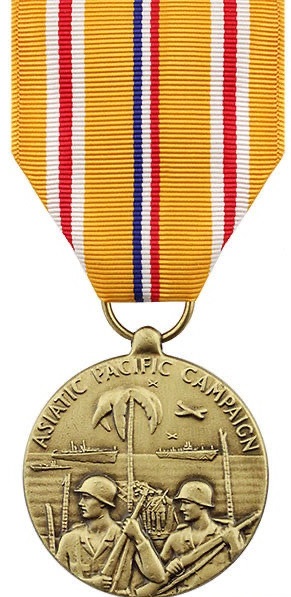
|
American Campaign Medal

|
EAME Campaign
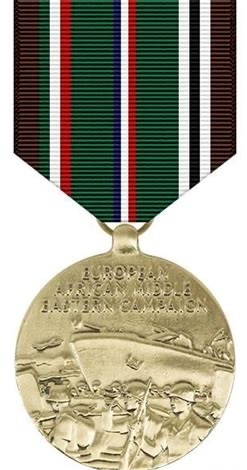
|
Life after the War
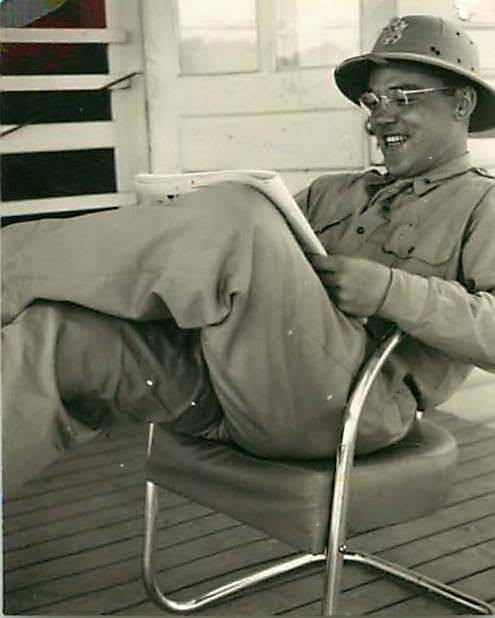
My father joined the reserves after his return from India. He was promoted to Major in 1946.
He resigned from the Reserves when he was called up for the Korean War.
He was the father of four children at that time.
He continued in public health as the sanitarian for Olmstead County in Rochester Minnesota.
He decided to return to his first love of chemical engineering in 1957 and joined the 3M company in St. Paul in the new medical products division.
He worked at 3M for the rest of his career being an inventor of medical products.
3M retained the ownership of the several patents for his inventions.
In retirement, after many rounds of golf during winters in Myrtle Beach, SC my parents moved to Charlestown Retirement Community in Catonsville, MD in 1994.
My parents celebrated 71 years of marriage in April 2012.
They died seven weeks apart in September and November 2012.
References
The military history, malaria information, and photos are from the book, Medical Department United State Army in World War II, Preventative Medicine, Volume VI, Communicable Diseases, Malaria, Prepared and published under the direction of Lieutenant General Leonard D. Heaton, The Surgeon General, United States Army, Chapter VII written by John W. H. Rehn. PhD., Washington, DC 1963.
![]() Preventative Medicine in World War II: Malaria
Preventative Medicine in World War II: Malaria
Additional information: CBI Order of Battle, Medical Service Units, Malaria Control Units
Footnote 5 - DDT (from its trivial name, dichlorodiphenyltrichloroethane) is one of the most well known synthetic pesticides. It is a chemical with a long, unique, and controversial history. First synthesized in 1874, DDT's insecticidal properties were not discovered until 1939, and it was used with great success in the second half of World War II to control malaria and typhus among civilians and troops. The Swiss chemist Paul Hermann Müller was awarded the Nobel Prize in Physiology or Medicine in 1948 “for his discovery of the high efficiency of DDT as a contact poison against several arthropods.” After the war, DDT was made available for use as an agricultural insecticide, and soon its production and use skyrocketed.
American biologist Rachel Carson published Silent Spring in 1962. The book catalogued the environmental impacts of the indiscriminate spraying of DDT in the U.S. and questioned the logic of releasing large amounts of chemicals into the environment without fully understanding their effects on ecology or human health. The book suggested that DDT and other pesticides may cause cancer and that their agricultural use was a threat to wildlife, particularly birds. Its publication was one of the signature events in the birth of the environmental movement, and resulted in a large public outcry that eventually led to DDT being banned in the U.S. in 1972. DDT was subsequently banned for agricultural use worldwide under the Stockholm Convention, but its limited use in disease vector control continues to this day and remains controversial.
Along with the passage of the Endangered Species Act, the U.S. ban on DDT is cited by scientists as a major factor in the comeback of the bald eagle, the national bird of the United States, from near-extinction in the contiguous U.S.
![]() Wikipedia: DDT
Wikipedia: DDT
|
1 - CBI Lines of Communication (https://cbi-theater.com/transportation/transportation.html) 2 - Van Auken, H. A.: A History of Preventive Medicine in the U.S. Army Forces of the India-Burma Theater, 1942-45. (https://achh.army.mil/history/book-wwii-malaria-default) 3 - Van Auken, H. A.: A History of Preventive Medicine in the U.S. Army Forces of the India-Burma Theater, 1942-45. 4 - Malaria Foundation International (http://malaria.org) 5 - DDT from Wikipedia (http://en.wikipedia.org/wiki/DDT) 6 - Hump Express Main Page and March 22, 1945 issue (https://cbi-theater.com/hump_express/humpexpress.html) 7 - Appendix A (letter below) S.S. John W. Brown (https://www.ssjohnwbrown.org/) Rohna Classified (https://rohnaclassified.com/) CBI Order of Battle, Medical Service Units, Malaria Control Units (http://www.cbi-history.com/part_iv_med.html#18) China-Burma-India Theater (https://cbi-theater.com/) |
|
UNITED STATES ARMY FORCES IN THE FAR EAST FEMC: 710 A.P.O. 501 18 APRIL 1943 SUBJECT: Sanitary and Prevention Measures for the Control of Malaria TO: Commanding General, Sixth Army, APO 442. Commanding General, Fifth Air Force, APO 925. Commanding General, U.S.A. S.O.S., APO 501. a. Prior to movement of a command into a malarious area the following antimalaria measures will be made effective: (1) All available information bearing on health in the area will be collected and evaluated in order to determine the probable effect of these factors on the sickness rate of the troops. Special note will be made of the prevalence of malaria and other insect and water-borne diseases. (2) Where the military situation permits, especially trained medical personnel will be dispatched in advance of the troops to make a health survey of the area. Results of this survey will form a basis for estimating the relative health hazards of different locations under consideration for occupation or proposed tactical operations. (3) There will he attached to the staff of the commander, a malariologist or a medical officer especially qualified in tropical diseases, to advise the commander concerning the relative malaria hazards of various proposed camp and bivouac sites, and to inspect and supervise the anti-malaria work and discipline throughout the command. (4) When the nature of the tactical operation permits, the organization will have attached to it malaria survey and control units. (5) All commanding officers will take measures to form anti-malaria details in each company, squadron or smaller unit and will provide for the training of these details in anti-malaria work. Details will be made up on the basis of one (1) N.C.O. and two (2) enlisted men per infantry company, and a suitable proportionate number for each smaller unit or detachment. The routine anti-malaria work in each unit area will be done by these details, augmented, for the anti-malaria work as advised by the attached medical officer. (6) All military personnel will he thoroughly trained prior to departure in carrying out the anti-malaria measures. (7) Each individual will have in his possession the following items of anti-malaria supplies and equipment: Bar, mosquito, or hammock, jungle complete Headnet, mosquito Gloves, Mosquito Repellent, mosquito--2 oz. bottle Atabrine, tablets, 0.1 gm. (1 1/2 grams) --30 (8) Each organization will be issued the following one months maintenance stocks: Bars, mosquito ............................................................25 per 100 men Headnets, mosquito .....................................................10 per 100 men Gloves, mosquito ...................................................10 prs per 100 men Repellent mosquito ..................................... 2-oz. bottles per 100 men Atabrine, tablets ....................(1 1/2 grams) 3,000 tablets per 100 men Equipment: Sprayer, hand, insecticide 10 per each 100 men Sprayer, knapsack type 1 per each 200 or less men Malariol ( or Diesel Oil No.2) 50 gallon U.S. per sprayer, knapsack Insecticide, for use in hand sprayers 5 gallons U.S. per 100 men These unit anti-malaria supplies will be conspicuously marked and must be carried in a readily accessible place on the ship, to be available immediately upon arrival. (5) Individual protective measures will be carried out as follows: a.) The wearing of shorts, and shirts without sleeves is prohibited. Work details may during daylight hours work without shirts when so authorized by the officer in charge of the detail. All troops will wear their shirt sleeves rolled down from sunset to sunrise. Leggings will be worn to protect ankles and legs from mosquito bites and from injuries leading to tropical sores. b.) All personnel will be required to sleep under mosquito nets. Unit commanders or their representatives will instruct the troops in the proper use of sleeping nets; and by frequent inspections at night will see that the nets are efficiently used. c.) Mosquito headnets and gloves will be worn while on guard duty or other night work whenever this is possible. Officers and men who, because of their work are unable to wear gloves and headnets, will cover all exposed skin surfaces with repellent. The repellent must be re-applied every few hours to be effective. (6) Anti-mosquito measures as follows, will be initiated upon arrival in malarious area (a) Hand killing of engorged mosquitoes will be done daily in each tent and hut within the area. (b) Each tent, hut, or sleeping place will be sprayed daily with insecticide to kill the infected mosquitoes. (c) Breeding places for mosquito larvae within half a mile radius of the camp site will be drained, filled or oiled by the unit anti-malaria detail. Especial attention will be directed to standing water in man-made excavations, wheel ruts, coconut shells, cans, and other containers. It is the responsibility of the commanding officer to see that the program for the destruction of breeding places is efficiently carried out. By command of General MACARTHUR. s/ L. S. OSTRANDER t/ L. S. OSTRANDER Adjutant General. |